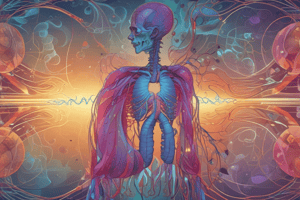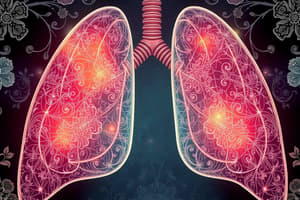Podcast
Questions and Answers
What is the role of the surface area to volume ratio in organisms?
What is the role of the surface area to volume ratio in organisms?
The surface area to volume ratio plays a significant role in determining the types of adaptations an organism will have. For example, small organisms have a large surface area to volume ratio, which allows for efficient diffusion of substances, while larger organisms have a smaller surface area to volume ratio, leading to adaptations like villi and microvilli for more efficient absorption.
What are the key adaptations that help larger organisms exchange substances more efficiently?
What are the key adaptations that help larger organisms exchange substances more efficiently?
Large organisms have adaptations such as villi and microvilli for efficient absorption of digested food, alveoli and bronchioles for gas exchange in mammals, spiracles and tracheoles for gas exchange in terrestrial insects, gill filaments and lamellae for gas exchange in fish, thin wide leaves for gas exchange in plants, and many capillaries for efficient exchange at tissues.
Which of these is NOT a key adaptation for efficient gas exchange in terrestrial insects?
Which of these is NOT a key adaptation for efficient gas exchange in terrestrial insects?
- Thin walls of tracheoles
- A large number of fine tracheoles
- Steep diffusion gradients due to oxygen and carbon dioxide
- Large surface area to volume ratio (correct)
The tracheal system in insects includes lungs.
The tracheal system in insects includes lungs.
What is the countercurrent flow mechanism in fish gills?
What is the countercurrent flow mechanism in fish gills?
What are the three key adaptations for efficient gas exchange in plants?
What are the three key adaptations for efficient gas exchange in plants?
What are some of the adaptations that help xerophytic plants survive in environments with limited water?
What are some of the adaptations that help xerophytic plants survive in environments with limited water?
What are the three main features that all gas exchange surfaces share?
What are the three main features that all gas exchange surfaces share?
What is the role of the circulatory system in mammals?
What is the role of the circulatory system in mammals?
What is the function of the valves in the heart?
What is the function of the valves in the heart?
The left ventricle pumps blood to the lungs.
The left ventricle pumps blood to the lungs.
What causes the Bohr effect?
What causes the Bohr effect?
What is the difference between how llamas and humans load oxygen onto haemoglobin?
What is the difference between how llamas and humans load oxygen onto haemoglobin?
How does root pressure contribute to the movement of water up the xylem?
How does root pressure contribute to the movement of water up the xylem?
Explain the concept of translocation in plants.
Explain the concept of translocation in plants.
What is the role of companion cells in phloem?
What is the role of companion cells in phloem?
How do tracing and ringing experiments help us understand translocation in plants?
How do tracing and ringing experiments help us understand translocation in plants?
Flashcards
Exchange of substances
Exchange of substances
The movement of substances into and out of cells and organisms.
Surface area
Surface area
The total area of the outer surface of an organism or structure.
Volume
Volume
The amount of space occupied by an organism or structure.
Surface area to volume ratio
Surface area to volume ratio
Signup and view all the flashcards
Diffusion
Diffusion
Signup and view all the flashcards
Adaptations in larger organisms
Adaptations in larger organisms
Signup and view all the flashcards
Villi
Villi
Signup and view all the flashcards
Microvilli
Microvilli
Signup and view all the flashcards
Alveoli
Alveoli
Signup and view all the flashcards
Bronchioles
Bronchioles
Signup and view all the flashcards
Bronchi
Bronchi
Signup and view all the flashcards
Trachea
Trachea
Signup and view all the flashcards
Lungs
Lungs
Signup and view all the flashcards
Ventilation
Ventilation
Signup and view all the flashcards
Diaphragm
Diaphragm
Signup and view all the flashcards
Inhale
Inhale
Signup and view all the flashcards
Exhale
Exhale
Signup and view all the flashcards
Antagonistic muscles
Antagonistic muscles
Signup and view all the flashcards
Pleural membranes
Pleural membranes
Signup and view all the flashcards
Gill filaments and lamellae
Gill filaments and lamellae
Signup and view all the flashcards
Countercurrent flow
Countercurrent flow
Signup and view all the flashcards
Spiracles
Spiracles
Signup and view all the flashcards
Trachea
Trachea
Signup and view all the flashcards
Tracheoles
Tracheoles
Signup and view all the flashcards
Mass transport
Mass transport
Signup and view all the flashcards
Anaerobic respiration
Anaerobic respiration
Signup and view all the flashcards
Mesophyll
Mesophyll
Signup and view all the flashcards
Stomata
Stomata
Signup and view all the flashcards
Guard cells
Guard cells
Signup and view all the flashcards
Xerophytes
Xerophytes
Signup and view all the flashcards
Translocation
Translocation
Signup and view all the flashcards
Xylem
Xylem
Signup and view all the flashcards
Phloem
Phloem
Signup and view all the flashcards
Cohesion-tension theory
Cohesion-tension theory
Signup and view all the flashcards
Haemoglobin
Haemoglobin
Signup and view all the flashcards
Oxyhaemoglobin dissociation curve
Oxyhaemoglobin dissociation curve
Signup and view all the flashcards
Affinity of haemoglobin for oxygen
Affinity of haemoglobin for oxygen
Signup and view all the flashcards
Loading of haemoglobin
Loading of haemoglobin
Signup and view all the flashcards
Unloading of haemoglobin
Unloading of haemoglobin
Signup and view all the flashcards
Partial pressure
Partial pressure
Signup and view all the flashcards
Cooperative binding of oxygen to haemoglobin
Cooperative binding of oxygen to haemoglobin
Signup and view all the flashcards
Bohr effect
Bohr effect
Signup and view all the flashcards
Double circulatory system
Double circulatory system
Signup and view all the flashcards
Arteries
Arteries
Signup and view all the flashcards
Veins
Veins
Signup and view all the flashcards
Capillaries
Capillaries
Signup and view all the flashcards
Tissue fluid
Tissue fluid
Signup and view all the flashcards
Hydrostatic pressure
Hydrostatic pressure
Signup and view all the flashcards
Ultrafiltration
Ultrafiltration
Signup and view all the flashcards
Water potential
Water potential
Signup and view all the flashcards
Osmosis
Osmosis
Signup and view all the flashcards
Cardiac muscle
Cardiac muscle
Signup and view all the flashcards
Myogenic
Myogenic
Signup and view all the flashcards
Coronary arteries
Coronary arteries
Signup and view all the flashcards
Aorta
Aorta
Signup and view all the flashcards
Vena cava
Vena cava
Signup and view all the flashcards
Pulmonary artery
Pulmonary artery
Signup and view all the flashcards
Pulmonary vein
Pulmonary vein
Signup and view all the flashcards
Atrioventricular valves
Atrioventricular valves
Signup and view all the flashcards
Semilunar valves
Semilunar valves
Signup and view all the flashcards
Septum
Septum
Signup and view all the flashcards
Cardiac output
Cardiac output
Signup and view all the flashcards
Diastole
Diastole
Signup and view all the flashcards
Atrial systole
Atrial systole
Signup and view all the flashcards
Ventricular systole
Ventricular systole
Signup and view all the flashcards
Study Notes
Gas Exchange in Organisms
- Organisms have adaptations for efficient gas transport.
- The ratio of surface area to volume is significant; smaller organisms have a large surface area relative to volume, facilitating diffusion.
- Larger organisms have a smaller surface area relative to volume, requiring more complex adaptations like specialized respiratory systems.
Examples of Adaptations
- Small organisms (e.g., amoeba): Exchange substances across their entire surface via simple diffusion.
- Larger organisms (e.g., mammals): Have specialized structures like alveoli in lungs for efficient gas exchange.
- Terrestrial insects: Use a tracheal system with branching tubes and spiracles for gas exchange.
- Fish: Utilize gills with lamellae to increase surface area and employ countercurrent flow for efficient oxygen extraction from water.
- Plants (e.g., leaves): Use stomata (pores) on leaves for gas exchange, with guard cells to regulate opening and closing, optimizing gas exchange while reducing water loss.
Human Gas Exchange System
- The key structures are alveoli, bronchioles, bronchi, trachea, and lungs.
- Ventilation: Inhaling and exhaling; controlled by the diaphragm and intercostal muscles. This process regulates air pressure changes in the lungs to allow air to enter and exit.
- Mechanism: External intercostal muscles contract to expand the thoracic cavity, decreasing lung pressure below atmospheric pressure, causing inhalation (inspiration). Relaxation of the external intercostal muscles and contraction of the internal intercostals causes exhalation (expiration). The diaphragm contracts during inhalation, creating a vacuum in the chest cavity, pulling air into the lungs.
- Gas exchange in alveoli: Occurs through diffusion, driven by the concentration difference between inhaled air and the blood.
Digestion and Absorption
- Digestion breaks down large molecules into smaller ones, absorptable across cell membranes.
- Carbohydrates: Hydrolyzed by amylase in the mouth and duodenum, and disaccharidases in the ileum, into monosaccharides.
- Proteins: Hydrolyzed by endopeptidases, exopeptidases, and dipeptidases into amino acids.
- Lipids: Emulsified by bile salts, then hydrolysed by lipase into glycerol and fatty acids.
- Absorption: Molecules are absorbed across the epithelial cells lining the ileum, primarily via villi and microvilli, maximizing surface area for optimal absorption.
- Mechanisms: Different mechanisms of absorption occur for different nutrients (e.g., glucose absorption through co-transport).
Mass Transport in Animals
- Haemoglobin: A protein in red blood cells, carrying oxygen.
- Affinity: Haemoglobin's ability to bind with oxygen. Loading and unloading occur at different partial pressures.
- Dissociation curves: Show how oxygen levels affect haemoglobin binding (affinity). Higher affinity means more oxygen binds at low partial pressures.
- Bohr effect: The change in haemoglobin's affinity for oxygen caused by changes in carbon dioxide and pH. This regulates oxygen delivery to respiring tissues.
Mass Transport in Plants
- Translocation: Movement of sugars (like sucrose) from source (photosynthesizing leaves) to sinks (respiring/storage tissues).
- Mechanism: The mass flow hypothesis explains this process through differences in hydrostatic pressure created in the phloem by active translocation of sugars.
- Phloem: The vascular tissue responsible for translocation.
- Sieve tube elements and companion cells: Active loading of sucrose at the source lowers the water potential, leading to water entering the phloem. The increased hydrostatic pressure drives translocation to locations with lower pressure, like storage tissues or growing regions.
Studying That Suits You
Use AI to generate personalized quizzes and flashcards to suit your learning preferences.




